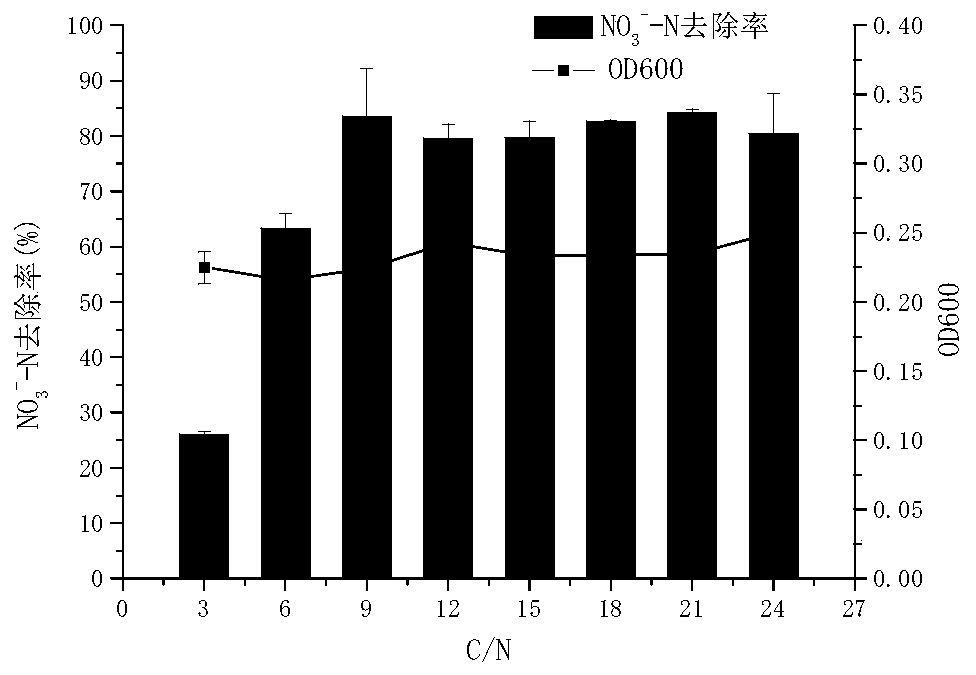A strain of sea bacterium with aerobic denitrification ability and its application
An aerobic denitrification and sea bacillus technology, applied in bacteria, chemical instruments and methods, microorganism-based methods, etc., can solve the problem of less salt-tolerant aerobic denitrification bacteria, achieve easy collection and fixation, and increase practical performance Effect
- Summary
- Abstract
- Description
- Claims
- Application Information
AI Technical Summary
Problems solved by technology
Method used
Image
Examples
Embodiment 1
[0039] Example 1 Isolation and Identification of Marinobacter sp. 1A14215
[0040] 1. Isolation of bacterial strains: take the sediment overlying water sample of 4432m in the Southwest Indian Ocean (E50 ° 45.06' S33 ° 16.74'), adopt the gradient dilution coating plate method, and use the Marine Agar solid medium to coat the plate for separation and purification to obtain Marinobacter (Marinobacter sp.) 1A14215 single bacteria.
[0041] 2. Physiological and biochemical characteristics and molecular identification of the strain
[0042] Morphological characteristics: Marinobacter sp. 1A14215, Gram-negative, cultured on Marine Agar solid medium at 28°C for 48 hours, the colonies are beige, smooth, slightly raised, with regular, opaque edges, and the diameter of the colonies is about It is 1~2mm. Individual strains are rod-shaped, without spores, and have flagella.
[0043] Physiological and biochemical characteristics: Marinobacter sp. 1A14215 grows at a salinity of 0-12%, and...
Embodiment 2
[0047] Example 2 Marinobacter sp. 1A14215 draft genome sequencing and denitrification gene analysis
[0048] Genomic DNA of Marinobacter sp. 1A14215 was extracted according to conventional methods, and sent to Shanghai Meiji Gene Co., Ltd., using the Hiseq platform for genome draft sequencing, and quality control, assembly and annotation of the obtained sequences. After annotation, it was found that the genome of Marinobacter sp. 1A14215 has a complete denitrification metabolic pathway: including nitrate reductase gene (nar), nitrite reductase gene (nir), nitric oxide reductase gene (nor) , nitrous oxide reductase gene (nos), and other denitrification-related transport regulatory genes.
Embodiment 3
[0049] Example 3 Optimization of Nitrogen Removal Conditions for Marinobacter sp. 1A14215
[0050] Pick a single colony of Marinobacter sp. 1A14215 and inoculate it into 100 mL of Marine Broth2216 (purchased from BD Difco) liquid medium. After culturing at 150 rpm at 28°C for 24 hours, take 30 mL of centrifuge to collect the bacteria, resuspend in 0.8% saline, Centrifuge, wash repeatedly 2 to 3 times, and finally make a bacterial suspension with normal saline, and adjust the concentration of the bacterial solution to 2×10 8 cfu / mL, inoculate with 0.2% inoculum to contain 140mg / L NO 3 - In the basal medium of -N, the denitrification conditions of the strains were measured under different carbon sources, C / N ratios, pH values, salinity, and temperature conditions, and the denitrification conditions were optimized.
[0051] Basal medium: KH 2 PO 4 0.5g / L, Na 2 HPO 4 0.5g / L, MgSO 4 ·7H 2 O 0.05g / L, FeSO 4 ·7H 2 O0.02g / L, CaCl 2 0.02g / L, distilled water 1000mL, steriliz...
PUM
| Property | Measurement | Unit |
|---|---|---|
| denitrification rate | aaaaa | aaaaa |
| denitrification rate | aaaaa | aaaaa |
| denitrification rate | aaaaa | aaaaa |
Abstract
Description
Claims
Application Information
 Login to View More
Login to View More - R&D
- Intellectual Property
- Life Sciences
- Materials
- Tech Scout
- Unparalleled Data Quality
- Higher Quality Content
- 60% Fewer Hallucinations
Browse by: Latest US Patents, China's latest patents, Technical Efficacy Thesaurus, Application Domain, Technology Topic, Popular Technical Reports.
© 2025 PatSnap. All rights reserved.Legal|Privacy policy|Modern Slavery Act Transparency Statement|Sitemap|About US| Contact US: help@patsnap.com



